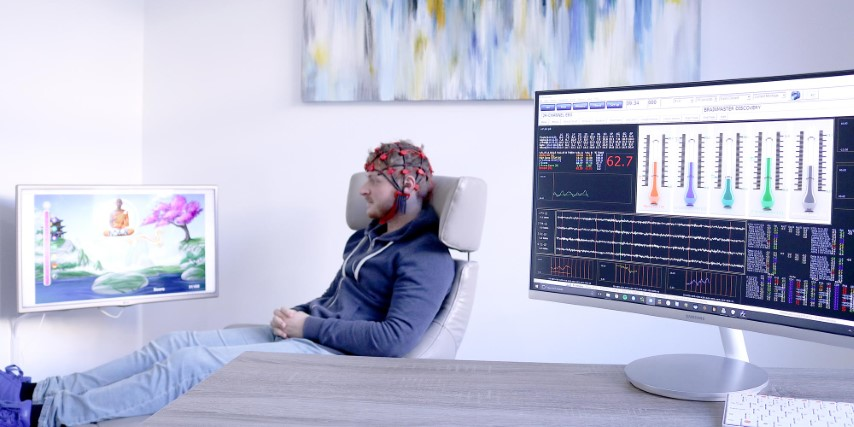
Neurofeedback is an advanced technology that uses brain waves to increase brain activity by monitoring them and providing feedback immediately. It is called “brain rewiring” because it alters the thinking patterns and emotions to improve mental health. Understanding how these pathways are affected by neurofeedback is critical in understanding its potential benefits for mental well-being.
What is neurofeedback, and how does it work?
Neurofeedback trains the brain to enhance function by monitoring and adjusting brainwave activity in real-time, leading to improved mental health and cognitive performance.
Neurofeedback is the use of a biofeedback technique that trains the brain to function better. It is a process where activity in a person’s brain is monitored, which ultimately helps the user learn to self-regulate his or her brain waves.
An individual can control brainwave patterns through neurofeedback by visual or auditory clues to guide them to any mental state they desire, thus improving focus and relaxation, leading to enhancement of cognitive performance.
The electrodes are applied to the scalp, and the client views a computer screen with the brainwaves showing in order to have self-regulation and neuroplasticity control.
Can neurofeedback rewire your brain effectively?
Neurofeedback promotes neuroplasticity, effectively rewiring the brain by forming new neural connections, enhancing emotional regulation, and improving cognitive functions.
Neurofeedback enhances the efficiency of rewiring the brain by increasing neuroplasticity, a process through which the brain forms new neural connections.
It helps in improving one’s emotional regulation and cognitive functions by training the brain to invent new activity patterns. After several sessions, some long-lasting changes could be achieved with special benefits for conditions like ADHD, anxiety, and PTSD.
Through the regulation of brainwaves, better flexibility and the processing of the brain can be done in information and emotions.
What are the benefits of neurofeedback therapy?
Neurofeedback therapy offers benefits like improved attention, reduced anxiety, better emotional regulation, and enhanced sleep, aiding in the management of ADHD and depression.
This kind of therapy has many benefits associated with it, such as attention improvement, anxiety reduction, regulation of emotional states, and improved sleep. It is highly effective in the symptomatic management of attention-deficit/hyperactivity disorder and depression.
Neurofeedback accomplishes this by training your brain to function more effectively, enabling long-term positive effects on your mental health. It enhances memory, focus, and relaxation and is a very individualized way of training the brain for self-regulation and performance improvement.

How does neurofeedback help with anxiety and stress?
Neurofeedback helps manage anxiety and stress by training the brain to maintain a calm state and adjust brainwave patterns associated with stress, improving resilience and emotional stability.
Neurofeedback helps in anxiety and stress by teaching the brain how to remain calm and balanced. It is training a person to recognize and change their brain wave pattern that results in stress.
The process reduces symptoms of anxiety and increases resilience, leading to better stress management and emotional stability.
Neurofeedback provides real-time feedback regarding brain activity and enables individuals to develop adaptive coping strategies to deal with anxious feelings, thereby obtaining better control over their emotional responses.
Is neurofeedback safe for children with ADHD?
Neurofeedback is a safe, non-invasive therapy for children with ADHD, helping improve attention, reduce impulsivity, and enhance focus without medication.
Neurofeedback is considered safe for children with ADHD, and it offers a non-invasive and non-medicated approach to controlling the symptoms of ADHD. The therapy works by enhancing the attention process through the reduction of impulsiveness and increasing focus by training the brain to work more effectively.
Many parents have thus found this to be a real alternative to medication. Neurofeedback helps children learn to concentrate and curb impulsive behaviors during sessions tailored to each child’s needs, complementing other treatments aimed at ADHD and rewarding desirable patterns of brainwaves.

How long does it take to see results from neurofeedback?
Results from neurofeedback vary; some notice changes after a few sessions, while others may need 20-40 sessions. Consistent practice is crucial for achieving lasting benefits.
The timeline to derive results from neurofeedback is wide-ranging. While some report improvement after a few sessions, others may need 20-40 sessions. Of course, this depends on the individual goals, as well as the severity of symptoms.
Benefits might at first include improved focus or decreased anxiety, and then more pervasive changes happen when the brain becomes more efficient at self-regulation. Regular sessions and ongoing practice are necessary to strengthen and maintain the neural pathways in the brain.
What conditions can neurofeedback treat effectively?
Neurofeedback effectively treats conditions like ADHD, anxiety, depression, PTSD, and sleep disorders and also supports cognitive enhancement and performance optimization.
It is also possible to work on attention deficit hyperactivity disorder, anxiety, depression, PTSD, sleep disorders, and cognitive enhancement/performance optimization.
Basically, neurofeedback works by improving symptoms and enhancing overall brain functioning by targeting specific brainwave patterns. In view of the ability to create neuroplasticity in the brain, it turns out to be valuable in matters that deal with mood, attention, and stress-related issues.
Treatment is individualized according to needs, hence providing an individualistic approach to mental health care that supports long-term recovery and well-being.
Are there any risks associated with neurofeedback?
Neurofeedback is generally safe with minimal risks. Some may experience temporary fatigue or headaches, but side effects are usually mild and resolve as the brain adjusts.
It is generally considered to be safe; there are very few risks associated with neurofeedback. Some people may report temporary fatigue or headaches as side effects, although generally these issues are very mild and go away quite quickly as the brain becomes adjusted to the training.
Working with a qualified professional ensures proper protocols are followed, thus minimizing possible adverse effects. Some people might be emotionally hypersensitive during the period of adjustment, but that happens quite rarely. Clearly communicating with practitioners helps in managing and mitigating potential concerns,
Conclusion
To sum up, the brain’s neuroplasticity can be redefined by neurofeedback and open new mental health avenues. We would advise seeking guidance from a skilled professional if you are contemplating this promising approach. It is our aspiration that it will take its place among the basic requirements of brain care and therapy which will make one’s life better by exploiting the brain plasticity in humans.

